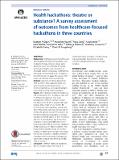| dc.contributor.author | Olson, Kristian R | en_US |
| dc.contributor.author | Walsh, Madeline | en_US |
| dc.contributor.author | Garg, Priya | en_US |
| dc.contributor.author | Steel, Alexis | en_US |
| dc.contributor.author | Mehta, Sahil | en_US |
| dc.contributor.author | Data, Santorino | en_US |
| dc.contributor.author | Petersen, Rebecca | en_US |
| dc.contributor.author | Guarino, Anthony J | en_US |
| dc.contributor.author | Bailey, Elizabeth | en_US |
| dc.contributor.author | Bangsberg, David R | en_US |
| dc.date.accessioned | 2017-03-28T23:49:51Z | |
| dc.date.issued | 2017 | en_US |
| dc.identifier.citation | Olson, Kristian R, Madeline Walsh, Priya Garg, Alexis Steel, Sahil Mehta, Santorino Data, Rebecca Petersen, Anthony J Guarino, Elizabeth Bailey, and David R Bangsberg. 2017. “Health hackathons: theatre or substance? A survey assessment of outcomes from healthcare-focused hackathons in three countries.” BMJ Innovations 3 (1): 37-44. doi:10.1136/bmjinnov-2016-000147. http://dx.doi.org/10.1136/bmjinnov-2016-000147. | en |
| dc.identifier.issn | | en |
| dc.identifier.uri | http://nrs.harvard.edu/urn-3:HUL.InstRepos:31731765 | |
| dc.description.abstract | Background: Healthcare-focused hackathons are 48-hour platforms intended to accelerate novel medical technology. However, debate exists about how much they contribute to medical technology innovation. The Consortium for Affordable Medical Technologies (CAMTech) has developed a three-pronged model to maximise their effectiveness. To gauge the success of this model, we examined follow-up outcomes. Methods: Outcomes of 12 hackathons from 2012 to 2015 in India, Uganda and the USA were measured using emailed surveys. To minimise response bias, non-responding teams were coded as having made no progress. Results: 331 individuals provided information on 196 of 356 projects (55.1% response rate), with no difference in responses from teams participating in different countries (Cramer's V=0.09, p=0.17). 30.3% of projects had made progress after a mean of 12.2 months. 88 (24.7%) teams had initiated pilot testing, with 42 (11.8%) piloting with care providers and 24 (6.7%) with patients. Overall, 97 teams (8.1 per hackathon) drafted business plans, 22 (1.8 per hackathon) had filed patents on their innovations and 15 (1.3 per hackathon) had formed new companies. Teams raised US$64.08 million in funding (average US$5.34 million per hackathon; median award size of $1800). In addition, 108 teams (30.3%) reported at least one member working on additional technologies with people they met at a hackathon. Individual confidence to address medical technology challenges was significantly increased after attending (t(1282)=192.77, p 0.001). Conclusion: CAMTech healthcare hackathons lead to consistent output with respect to medical technology innovation, including clinical trials, business plan development, securing investment capital/funding and new company formation. | en |
| dc.language.iso | en_US | en |
| dc.publisher | BMJ Publishing Group | en |
| dc.relation.isversionof | doi:10.1136/bmjinnov-2016-000147 | en |
| dc.relation.hasversion | http://www.ncbi.nlm.nih.gov/pmc/articles/PMC5293858/pdf/ | en |
| dash.license | LAA | en_US |
| dc.subject | hackathons | en |
| dc.subject | medical devices | en |
| dc.subject | innovations | en |
| dc.subject | low and middle income countries | en |
| dc.subject | value | en |
| dc.title | Health hackathons: theatre or substance? A survey assessment of outcomes from healthcare-focused hackathons in three countries | en |
| dc.type | Journal Article | en_US |
| dc.description.version | Version of Record | en |
| dc.relation.journal | BMJ Innovations | en |
| dash.depositing.author | Olson, Kristian R | en_US |
| dc.date.available | 2017-03-28T23:49:51Z | |
| dc.identifier.doi | 10.1136/bmjinnov-2016-000147 | * |
| dash.contributor.affiliated | Olson, Kristian | |


